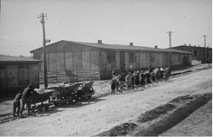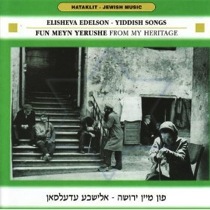The Holocaust Living History Workshop to Host Three “Living With History” Events in Fall 2011
Oct. 5, Nov. 9, and Nov. 22 events to be held in the Seuss Room in UCSD's Geisel Library from 5 to 7 p.m.
By:
- Dolores Davies
Published Date
By:
- Dolores Davies
Share This:
Article Content

Work Kommando in Plaszow Concentration Camp (Krakow)
The Holocaust Living History Workshop (HLHW), sponsored by the UC San Diego Libraries and the Judaic Studies Program, will host three events during the fall quarter as part of the HLHW’s ongoing effort to broaden understanding of the past and to foster tolerance. At the events, all of which are free and open to the public, attendees will have the opportunity to hear local Holocaust survivors share their stories and to learn about the Visual History Archive, the world’s largest database of Holocaust testimony.
At the first HLHW event on October 5, Agatha Ehrenfried will present “Under the Shadow of the Holocaust,” about her experiences during the Nazi period. Her talk is the tale of a young woman suddenly flung from the security of her home into the terror of the camps. Ehrenfried grew up in Rakosliget, Hungary, and was 21 years old when the Germans occupied her country and began to round up the Jews. During the following year, she passed through several concentration camps including Auschwitz-Birkenau and Plaszow (Krakow), an experience that would forever be etched in her mind. Ehrenfried will be introduced by local philanthropist and community leader Phyllis Epstein, an active supporter of the USC Shoah Foundation Institute.
On November 9, 1938, the Nazis unleashed the pogrom that came to be known as Kristallnacht (Crystal Night). At the time, Gerhard Maschkowski was barely 14 years old. On November 9, 2011—the 73rd anniversary of Kristallnacht—Maschkowski will share the impact these events have had on his life. The son of a WWI veteran blinded in combat, Maschkowski grew up in West Prussian Elbing, where he experienced prejudice and persecution firsthand. In the wake of Kristallnacht, he was sent to the forced labor camps of Jessenmühle and Neuendorf. From there, he was deported to Auschwitz-Monowitz, where he worked in a cement and an electricians’ detachment. After barely surviving a grueling death march, he ended up in a hospital in Breslau, which the Russians liberated in early May 1945. UC San Diego Sociology Professor Richard Biernacki will provide introductory remarks to the talk.

Death March (painting by Jan Hartman, a survivor of Auschwitz and a death march)
The last HLHW event for fall is a November 22 talk on “Musical Journeys: Shtetl, Ghetto, Israel,” featuring San Diego singer and educator Elisheva Edelson. The daughter of a survivor who lost his parents and siblings in the Holocaust, Edelson learned her first Yiddish songs from her father. Subsequently, she studied at Der Yiddisher Shule in Mexico, where she became actively involved in Holocaust memorialization. At the event, Edelson will teach and perform songs in Yiddish, Ladino, and Hebrew. She will also share her thoughts on the significance of music to the modern Jewish experience, and talk about how music functioned as a type of resistance under oppression. Local Holocaust survivors will attend the event, some of whom heard these songs while growing up in Central and Eastern Europe.
The UC San Diego Libraries are one of only three university libraries on the West Coast to have access to the USC Shoah Foundation Institute Visual History Archive, founded by film maker Steven Spielberg to document the stories of Holocaust survivors for his movie, “Schindler’s List.” In 1994, Spielberg established the Survivors of the Shoah Visual History Foundation, a non-profit organization, to collect and preserve more than 50,000 firsthand accounts of survivors and other witnesses of the Holocaust. The foundation became the USC Shoah Foundation Institute for Visual History and Educationin 2006.

The Holocaust Living History Workshop, launched in 2007, aims to teach the history of the Holocaust through two methods of face-to-face contact, both with Holocaust survivors and their children and through the Visual History Archive. Student volunteers have received special training on how to search through the testimonies in the massive Archive, and then teach survivors and their families—from multiple generations—how to use the database. These families can then use the archive to conduct their own searches in order to learn about other people, and in some cases relatives, who had similar Holocaust experiences. Since its inception in 2007, more than 1000 people have attended Workshop presentations and events at UC San Diego.
The archive of 52,000 digital oral histories recorded by Holocaust survivors and other witnesses is the foundation for the Holocaust Living History Workshop, a program that has brought together UC San Diego students, San Diego holocaust survivors, and their children. The Workshop, which was established to expand the usefulness and the impact of the Archive, has proven to be a powerful tool for discovering family history and preserving memories for survivors, their families, and members of the community.
The Visual History Archive, which includes the testimonies of Holocaust survivors from 40,000 specific geographic locations in languages ranging from Bulgarian and Greek to Japanese and Spanish, can be accessed by members of the campus community and the public from any computer on the UC San Diego campus.
For more information about UC San Diego's Holocaust Living History Workshop, contact Susanne Hillman at hlhw@ucsd.edu or go to:
http://libraries.ucsd.edu/hlhw. Training in the use of the Visual History Archiveis available for individuals and groups upon appointment.
The UC San Diego Libraries, ranked among the top 20 public academic research libraries in the nation, play an integral role in advancing and supporting the university's research, teaching, patient care, and public service missions. The UC San Diego Libraries provide access to more than 7 million digital and print volumes, journals, and multimedia materials to meet the knowledge demands of scholars, students, and members of the public. Each day, the Libraries' vast resources and services are accessed more than 87,500 times via the UCSD Libraries' Web site.
Share This:
Stay in the Know
Keep up with all the latest from UC San Diego. Subscribe to the newsletter today.



